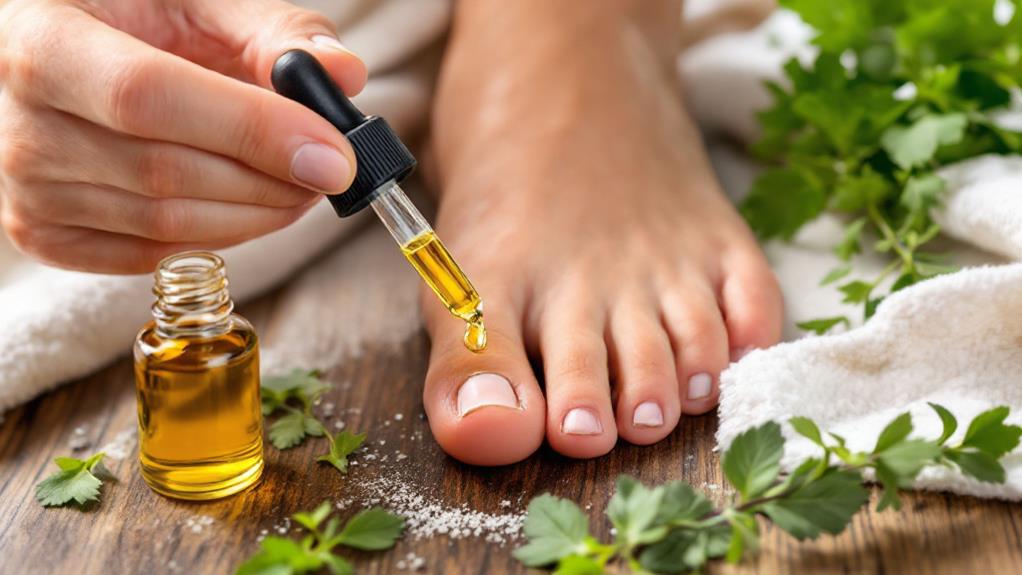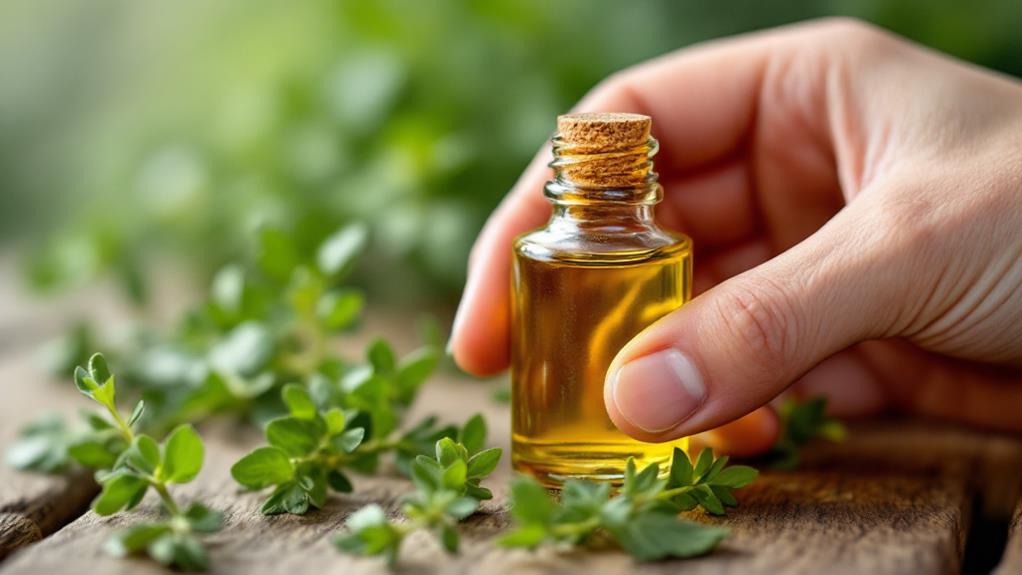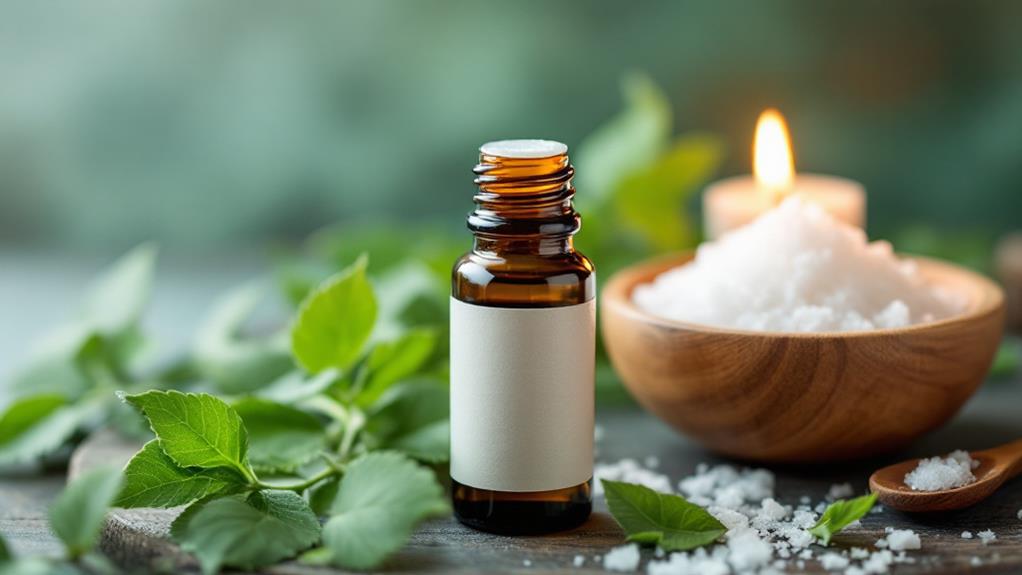How to Treat Toenail Fungus With Oregano Oil: a Step-By-Step Guide

To treat toenail fungus with oregano oil, start by selecting a high-quality, therapeutic-grade oregano oil with at least 70% carvacrol concentration. Clean and dry the affected nail thoroughly. Dilute 1-2 drops of oregano oil with a teaspoon of carrier oil like coconut. Test for any allergic reaction on a small area of skin. Apply the mixture using a cotton swab to the toenail and surrounding skin once or twice daily. Monitor for improvements and any sensitivity. If the condition persists, consult a healthcare professional. There's definitely more to reveal about this powerful natural remedy.
Understanding Toenail Fungus
Toenail fungus, a common yet often misunderstood condition, arises when fungi like dermatophytes, yeasts, or molds overgrow and invade the nails. This fungal infection, medically known as onychomycosis, can lead to noticeable symptoms such as discoloration and thickening of the nails. You might notice your nails turning yellow or brown, becoming brittle, or even detaching from the nail bed. These changes can cause discomfort, especially when walking.
Understanding the risk factors is essential for early recognition and prevention. If you have diabetes, poor circulation, or a compromised immune system, you're at a higher risk of developing toenail fungus. Moreover, spending time in damp environments, like swimming pools or locker rooms, can increase your susceptibility to infections. Recognizing these risk factors can help you take preventive measures and seek treatment promptly.
If left untreated, toenail fungus can progress, potentially leading to more severe complications and significant pain. While the condition might seem minor initially, early recognition and intervention are vital. Addressing toenail fungus early can prevent long-term issues and provide health benefits by maintaining the integrity of your nails.
Benefits of Oregano Oil
Among the numerous natural remedies available, oregano oil stands out due to its potent antifungal properties, thanks to compounds like carvacrol and thymol. These compounds effectively inhibit the growth of fungi responsible for toenail fungus, making oregano oil a dependable option for tackling stubborn infections. Regular application not only targets the fungus but also promotes better nail health, often showing visible improvements within weeks.
When using oregano oil for toenail fungus, it's essential to approach it with care. While it's generally safe for topical use, you must dilute it with a carrier oil to prevent skin irritation. This guarantees that you can enjoy the full benefits of this natural remedy without any discomfort.
Here are some benefits of using oregano oil:
- Fights diverse fungal infections: Beyond toenail fungus, oregano oil can tackle athlete's foot and ringworm, offering a thorough solution.
- Promotes healthy nail growth: Once the infection is cleared, the oil supports healthier nails.
- Safe for regular use: With proper dilution, it becomes a gentle yet effective part of your routine.
Embrace oregano oil as a holistic treatment, enhancing both your nail health and overall well-being.
Choosing the Right Oregano Oil

Curious about how to choose the best oregano oil for treating toenail fungus? Start by looking for high-quality, therapeutic-grade oregano oil. This guarantees you're getting the most potent and effective product available. Pay attention to the carvacrol content, the key compound responsible for antifungal properties; aim for oil with at least 70% carvacrol concentration. This concentration optimizes the oil's ability to combat toenail fungus effectively.
Opt for oregano oil that is labeled as 100% pure and organic. Avoid oils with additives or synthetic ingredients, as they can diminish the oil's effectiveness and potentially irritate your skin. The purity of the oil is essential, so always check the label carefully.
Consider buying oregano oil packaged in dark glass bottles. These bottles protect the oil from light degradation, preserving its therapeutic qualities over time. Furthermore, look for products that have undergone third-party testing or hold certifications. These validations confirm the oil's purity and quality, giving you confidence in your choice.
Preparing for Treatment
Getting ready to tackle toenail fungus with oregano oil involves a few essential steps to guarantee effective treatment. Start by ensuring your oregano oil is high-quality, therapeutic-grade, and suitable for topical use. Begin the preparation process by cleaning and thoroughly drying the affected toenail. This step removes dirt and moisture, making your treatment more effective.
To prevent skin irritation, it's significant to dilute the oregano oil with a carrier oil such as coconut or olive oil. Mix 1-2 drops of oregano oil with 1 teaspoon of your chosen carrier oil. Before you apply the mixture to the affected toenail, conduct a patch test. This helps identify any potential allergic reactions or sensitivities. Simply:
- Apply a small amount of the diluted oil to a different area of skin.
- Wait 24 hours to monitor for any adverse reactions.
- Proceed if there's no skin irritation or discomfort.
Gather your supplies, including a cotton swab or fingertip for application and a mirror for better visibility. These steps are fundamental parts of your preparation, ensuring you're ready to tackle toenail fungus effectively while minimizing potential side effects.
Application Process
To effectively apply oregano oil for treating toenail fungus, confirm you start with clean and dry nails. This guarantees that the antifungal properties of the oregano oil can work effectively. Begin by selecting a pure, therapeutic-grade oregano oil, suitable for topical use. Before you apply it to the affected toenail, make certain to dilute 1-2 drops of oregano oil with 1 teaspoon of a carrier oil, like coconut or olive oil. This step is essential to minimize the risk of skin irritation.
Once you've prepared the diluted solution, use a cotton swab or your fingertip to apply a small amount to the toenail and surrounding skin. It's significant to confirm the oil penetrates deeply. For the best results, apply the diluted oregano oil once or twice daily. Consistency is key, so monitor progress over several weeks to see improvements.
Before you begin regular applications, conduct a patch test on a small area of skin to check for any adverse reactions. If you notice any sensitivity or irritation, discontinue use. By following these steps, you can harness the full antifungal potential of oregano oil.
Safety and Precautions
Guaranteeing safety and taking necessary precautions is vital when using oregano oil for toenail fungus treatment. Start by always diluting oregano oil with a suitable carrier oil, like coconut or olive oil. This dilution helps prevent potential irritation or allergic reactions on your skin. It's important to conduct a patch test on a small area before applying it to larger affected regions. This simple step can help you identify any skin sensitivities early on.
Remember to:
- Avoid contact with eyes and mucous membranes; rinse thoroughly with water if accidental contact occurs.
- Consult a healthcare professional if you encounter any adverse reactions or have underlying health conditions.
- Steer clear of oregano oil during pregnancy or breastfeeding due to potential safety concerns.
If you find any signs of irritation or discomfort, discontinue use and seek medical advice. Those with underlying health conditions should consult a healthcare professional before starting this treatment. It's always better to err on the side of caution. By taking these necessary precautions, you'll guarantee a safer experience while treating toenail fungus with oregano oil. Always prioritize your health and safety by being informed and cautious.
Monitoring Progress
Start by regularly inspecting your toenail to gauge the effectiveness of the oregano oil treatment. Look for signs of improvement, such as reduced discoloration and thickness. These changes might take several weeks to manifest, so patience is key. As you apply the oil, track the frequency of application—ideally 2-3 times daily—and observe any changes in your nail's texture or general health. Consistency is essential, so keep a routine to enhance the treatment's effectiveness.
Document symptoms and any side effects in a journal. This includes noting any irritation or allergic reactions like redness or itching. If you experience such reactions, consider adjusting the dilution of the oregano oil to mitigate sensitivity. Monitoring progress through these observations will help you assess the treatment's overall effectiveness.
If, after several weeks, there's little improvement or persistent symptoms, schedule a follow-up with a healthcare professional. They can provide further insights or suggest alternative therapies if needed. By keeping a detailed record and being proactive in monitoring your progress, you'll be better equipped to make informed decisions about your health and the next steps in your treatment process.
Combining With Other Remedies
Combining oregano oil with other natural remedies can improve its effectiveness against toenail fungus. You can create a powerful antifungal treatment by mixing oregano oil with tea tree oil. Both oils are packed with antifungal properties that target stubborn toenail infections. To minimize skin irritation, contemplate using a carrier oil like coconut or olive oil when you apply oregano oil. This not only soothes the skin but also helps in amplifying the benefits of the active compounds.
Here are some combined remedies to reflect upon:
- Tea Tree Oil: Mix with oregano oil for a potent antifungal blend.
- Apple Cider Vinegar: Soak your feet regularly, followed by applying oregano oil for a dual-action approach.
- Garlic: Crush and apply with oregano oil for an added antifungal punch.
For even more effectiveness, you can try alternating between oregano oil and other products like Vicks VapoRub. Regular application of these combined remedies can greatly elevate your fight against stubborn toenail fungus. Remember, consistency is key, so keep applying these treatments until you see an improvement. By leveraging these natural remedies together, you'll optimize your chances of overcoming toenail fungus.
Tips for Prevention
Alongside combining oregano oil with other remedies to tackle toenail fungus, it's essential to adopt preventive measures to keep infections at bay. Start by maintaining proper foot hygiene. Wash and thoroughly dry your feet daily to minimize moisture accumulation, which fosters fungal growth. Opt for breathable footwear and moisture-wicking socks to reduce dampness and promote airflow, vital to preventing toenail fungus.
Regularly trim and clean your toenails to avoid debris buildup, which can invite unwanted infections. Clean toenails are less likely to harbor fungi, reducing potential issues. When in communal areas like pools or locker rooms, wear flip-flops or shower shoes. This simple step minimizes exposure to fungi lurking in damp environments.
To further protect your feet, consider using antifungal powders or sprays inside your shoes. These products have antifungal properties that can help keep infections at bay, especially in frequently worn footwear. These preventive measures, combined with the potent effects of oregano oil, create a strong defense against toenail fungus.




